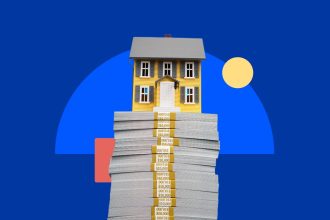Key takeaways
- A 7/1 ARM is a type of adjustable-rate mortgage (ARM) that has a fixed interest rate for the first seven years, then a variable rate that changes yearly until the end of the mortgage term.
- The initial fixed rate on a 7/1 ARM is usually lower than the rate on a comparable fixed-rate mortgage.
- A 7/1 ARM could be a good option if you know you’ll sell the home or refinance within the first seven years. Otherwise, a fixed rate might be better.
What is a 7/1 ARM?
A 7/1 adjustable-rate mortgage (ARM) comes with a fixed interest rate for the first seven years of the loan term. After that, the rate can change once a year — within certain limits — until the mortgage term ends, usually after 30 years.
These changes come with risk. If prevailing rates have decreased, your rate and your monthly payment will also decrease. But rates and your payment could increase, too. If you haven’t planned carefully, they could rise to an unaffordable level.
In addition to 7/1 ARMs, some mortgage lenders offer 7/6 ARMs. These also have a fixed introductory rate for the first seven years, but the variable rate adjusts every six months after that, rather than once per year.
Adjustable-rate mortgages vs. fixed-rate mortgages
Adjustable-rate mortgages are one home loan option, but most borrowers choose fixed-rate mortgages. Fixed-rate mortgages usually have higher rates than the initial rate on an ARM, but that rate never changes, insulating borrowers from market movements. If rates do decrease in the future, you can always refinance a fixed-rate loan.
How does a 7/1 ARM work?
ARM adjustments, including 7/1 ARM adjustments, are based on a benchmark or index rate. Many ARMs rely on the 11th District Cost of Funds Index (COFI) or the Secured Overnight Financing Rate (SOFR). Your lender will take this rate and add a margin to arrive at the rate you pay.
ARMs also have limits on how much the rate can increase: the first or initial adjustment cap, a periodic or subsequent adjustment cap and the lifetime cap.
Example of a 7/1 ARM
Let’s say you take out a 7/1 ARM in the amount of $320,000 at an initial rate of 6.67 percent. The mortgage is indexed against SOFR. It has a 3 percent first adjustment cap, a 2 percent periodic cap and an 8 percent lifetime cap.
In this scenario, you’ll have a fixed monthly payment of about $2,060 for the first seven years of the mortgage.
If SOFR has increased by the time your first adjustment hits, your rate will also increase, but within the loan’s parameters. Your rate can never go higher than 14.67 percent.
7/1 ARM requirements
The requirements for a 7/1 ARM vary by lender and loan type. For a conventional ARM, the minimum criteria include:
- 620 credit score
- 5 percent down payment
Pros and cons of a 7/1 ARM
Pros
- They’re typically cheaper at first. The introductory interest rate on a 7/1 ARM might be much lower than the rate on a 30-year, fixed mortgage. A lower rate means lower monthly payments.
- The payments might decrease. If prevailing interest rates are lower at the first rate adjustment or subsequent adjustments, you could save money.
- You’re protected — somewhat. Although there’s a real risk your rate will rise, there are caps that limit the increase.
Cons
- The risk never goes away. With every annual adjustment after those first seven years, your interest rate and payments could increase, even if they went down at first.
- It’s harder to budget. A mortgage is often a household’s largest monthly expense. Once your rate starts adjusting, it can be more challenging to plan for these payments.
- They have a more complicated structure. An adjustable-rate mortgage has more moving parts than a fixed-rate one, with an index, margin and caps. Some even have interest-only periods. This complexity can make it harder to understand how your rate and payments might change over time.
Should you get a 7/1 ARM?
While a 7/1 ARM comes with some risk, choosing one could make sense in a few situations. These include:
- You plan to refinance or sell before the first adjustment: If you don’t end up sticking with your home or loan long term, an ARM could save you money. But keep in mind, there’s no guarantee you’ll qualify to refinance or be able to sell your home within the seven-year timeline.
- You can reasonably expect your income to grow: If you can comfortably afford your initial ARM payments and expect your income to increase soon — maybe because you’re finishing a job training program — you may not need to worry about a higher monthly payment. But, again, there are no guarantees.
If you decide not to choose an ARM, the vast majority of borrowers pick a fixed-rate mortgage, which has stable principal and interest payments for the entire loan term.
Should you choose an ARM if you think rates will decrease?
You might be tempted to choose an ARM if you think interest rates are on the decline these days. But seven years is a long time, and there are many factors that could move mortgage rates in either direction between now and then. It’s not wise to pick an ARM with the assumption that rates will go down, especially if the highest possible monthly payment isn’t affordable.
Other types of adjustable-rate mortgages
7/1 ARMs are just one type of ARM. Other common options include:
- 10/1 ARM or 10/6 ARM: This has a fixed introductory rate for 10 years. The rate then adjusts annually (10/1) or every six months (10/6) afterward.
- 5/1 ARM or 5/6 ARM: This has a fixed introductory rate for five years. The rate then adjusts annually (5/1) or every six months (5/6) afterward.
- 3/1 ARM or 3/6 ARM: This has a fixed introductory rate for three years. The rate then adjusts annually (3/1) or every six months (3/6) afterward.
FAQ
Why we ask for feedback
Your feedback helps us improve our content and services. It takes less than a minute to
complete.
Your responses are anonymous and will only be used for improving our website.
Help us improve our content
Read the full article here














